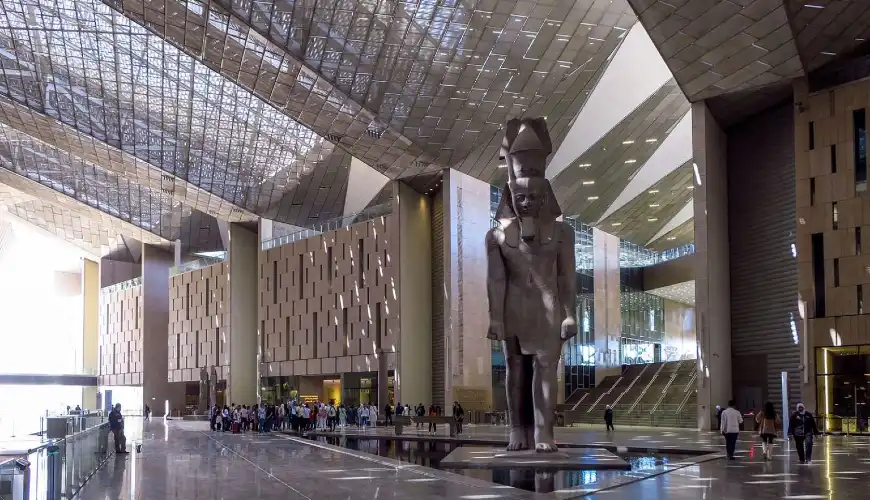Exploring the Grand Egyptian Museum's Design and Construction
I. Introduction
The Grand Egyptian Museum (GEM) stands as a testament to human ingenuity and a celebration of Egypt's ancient civilization. This architectural marvel, set to open its doors in the near future, serves as a sanctuary for showcasing and preserving the rich cultural heritage of Egypt. The museum's design and construction have been carefully crafted to honor the past, while also providing an immersive and captivating experience for visitors from around the world.
Table of Contents
The Grand Egyptian Museum is not just a building; it is an embodiment of Egypt's historical and cultural significance. With intricate design elements, innovative technologies, and meticulous attention to detail, the GEM seeks to offer a unique journey through ancient Egypt's timeless treasures. Its construction has been a meticulous process, with a deep sense of responsibility to preserve and present the nation's heritage to future generations.
As we delve into the design and construction of this monumental museum, we uncover a story of immense importance. It is a tale of architectural brilliance, cultural preservation, and national pride that will transport us back in time and leave us in awe of Egypt's past glory. Join us as we explore the Grand Egyptian Museum's design and construction, and unravel the secrets and wonders that await within its walls.
II. The Vision and Conceptualization
The Grand Egyptian Museum (GEM) emerged from a visionary idea to create a remarkable space that would house and preserve Egypt's rich cultural heritage. The initial vision for the GEM was centered around the idea of creating a world-class institution that would not only showcase Egypt's ancient treasures but also provide a modern and immersive experience for visitors from around the world. The museum aimed to become a global hub for Egyptology, where the past would be brought to life through innovative displays and interactive exhibits.
The location of the museum was carefully chosen to enhance its significance and accessibility. Situated just two kilometers away from the Giza Plateau, the GEM stands as a gateway to the ancient wonders of Egypt, providing visitors with a seamless experience of exploring both the museum's expansive collection and the nearby pyramids and Sphinx. The chosen location also allows for the integration of the GEM with the existing archaeological sites to create a cohesive and immersive historical journey.
The conceptualization process of the GEM involved extensive architectural competitions and design considerations. Renowned architects from around the world were invited to submit their proposals, showcasing their creativity and vision for the museum. The designs had to strike a delicate balance between respecting the ancient Egyptian heritage and incorporating modern architectural elements that would complement the landscape. The selection process involved thorough evaluations of the designs' functionality, aesthetics, and adherence to sustainable practices to ensure a truly world-class museum that would endure for generations to come.
III. Architectural Features and Design
The architectural features and design of the Grand Egyptian Museum (GEM) are truly astounding, paying homage to the ancient Egyptian civilization while incorporating modern elements. The overall architectural style of the GEM can be described as contemporary with a touch of traditional Egyptian motifs. The inspiration behind the design stems from the magnificent historical structures of Egypt, most notably the pyramids and temples.
One of the standout features of the GEM is the captivating glass facade that adorns the exterior. This modern element not only adds a contemporary touch to the overall design but also allows natural light to illuminate the interior, creating a sense of openness and connection with the outside world. Additionally, the inclusion of beautifully landscaped gardens further enhances the museum's aesthetic appeal, providing a serene and tranquil environment for visitors to enjoy.
What sets the GEM apart is its seamless integration of modern elements with traditional Egyptian motifs. The design team has meticulously incorporated elements such as hieroglyphic patterns, pharaoh-inspired sculptures, and symbolic motifs throughout the museum's architecture. This fusion of old and new creates a unique atmosphere that transports visitors back in time while still offering a modern and engaging museum experience.
Overall, the architectural features and design of the Grand Egyptian Museum are a true marvel, seamlessly blending the ancient and the contemporary. It serves as a testament to Egypt's rich history and cultural heritage, inviting visitors from around the world to immerse themselves in the wonders of this extraordinary civilization.
IV. Construction Challenges and Innovations
The construction of the Grand Egyptian Museum (GEM) presented numerous challenges that had to be overcome. Firstly, the sheer size and scale of the project posed logistical difficulties, requiring meticulous planning and organization. The transportation of heavy artifacts and materials, as well as the construction of the museum's massive structures, demanded innovative solutions.
To tackle these challenges, cutting-edge construction techniques and technologies were employed. One such innovation was the use of advanced 3D modeling and virtual reality simulations. This allowed the architects and engineers to visualize the museum's design in great detail and make necessary adjustments before the actual construction began. Additionally, state-of-the-art machinery and equipment were utilized to expedite the construction process.
Moreover, the implementation of sustainable practices and environmentally-friendly materials was a priority. From utilizing renewable energy sources to integrating water-saving systems, the construction of the GEM was carried out with a deep commitment to environmental responsibility.
Despite the complexities involved, the construction challenges of the GEM were met with resilience and innovation. Through meticulous planning, the use of advanced technologies, and the dedication of the construction team, the Grand Egyptian Museum has emerged as a testament to human perseverance and architectural brilliance.
V. Symbolism and Cultural Significance
The design of the Grand Egyptian Museum (GEM) incorporates various symbolic elements that pay homage to Egypt's rich cultural heritage. The architecture itself is a tribute to the ancient pyramids, with its sleek and streamlined form reminiscent of the triangular shape. The use of traditional Egyptian motifs and patterns in the interior and exterior decor further enhances the cultural symbolism. These elements not only serve as aesthetic features but also as a means to connect visitors with the country's ancient past.
The GEM goes beyond its architectural symbolism to reflect Egypt's cultural heritage and identity. It houses a vast collection of artifacts and relics that represent different periods of Egyptian history, spanning thousands of years. From the meticulously preserved mummies of pharaohs to the dazzling array of ancient treasures, the museum serves as a custodian of the nation's cultural legacy. By showcasing these artifacts, the GEM offers visitors a comprehensive understanding of Egypt's rich history, art, and civilization.
The Grand Egyptian Museum has had a significant impact on Egypt's tourism industry and national identity. As one of the largest and most modern museums in the world, it has become a major tourist attraction, drawing visitors from across the globe. This influx of tourism not only brings economic benefits but also fosters a sense of pride and appreciation for Egypt's cultural heritage. The GEM serves as a symbol of the country's commitment to preserving its past and sharing it with the world. Overall, the museum's cultural significance extends beyond its walls, influencing how Egypt is perceived and celebrated on a global scale.
VI. Conclusion
In conclusion, the Grand Egyptian Museum (GEM) stands as an architectural marvel, showcasing the rich cultural heritage of Egypt. With its meticulous design, incorporation of modern elements with traditional motifs, and innovative construction techniques, the GEM is a testament to human creativity and ingenuity. Its vast collection of artifacts and exhibits provides an immersive experience, allowing visitors to delve into Egypt's ancient civilization.
I encourage all readers to visit the Grand Egyptian Museum and witness its grandeur firsthand. Explore the wonders of the past, marvel at the intricacies of ancient artifacts, and gain a deeper appreciation for Egypt's rich history and cultural heritage. The GEM offers a unique opportunity to experience the magnificence of Egypt's ancient civilization and serves as a reminder of the enduring legacy left by our ancestors. Plan your visit and embark on a journey through time at this remarkable museum.



